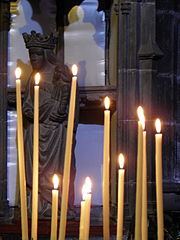
Dame Basilica, Le Folgoët, France
Wikimedia Commons: GO69
I spend a fair amount of time finding ways to connect with the sacred. It could be a Folk Shabbat service at a synagogue on Friday evening, a pagan ceremony honoring the divine feminine, an early morning walk in my neighborhood, a lama teaching at a Buddhist center, a hike in a foreign country, or the mesmerizing quality of da Vinci’s painting of the Last Supper. At this point in my life, I can sort of predict what rituals and practices will speak to me in a way that is meaningful, profound, and heartfelt. Occasionally, however, I am pleasantly surprised.
A couple of weeks ago, I attended a Sunday evening Taizé service at Grace Episcopal Church here in Asheville, NC. It’s a beautiful stone church built in the early 1900s on the site of the original log chapel. The night air had a pre-winter chill to it that followed me into the stone structure. The overhead lights, which provided only dim light for the sanctuary, were given a helping hand from the scores of candles lit on the altar. Two icons, painted in the Eastern Orthodox tradition and also lit by candles, were placed just in front of the altar.
It was a fairly typical Taizé service. The hour was spent singing songs, contemplating short passages from the Bible, and praying. Taizé songs are in various languages – such as Latin, French, English, and Italian – but the melodies are chant-like and repetitive. As a result, harmonies and rounds emerge effortlessly, even from novice singers. As we sang, some people moved toward the altar and offered prayers in front of the icons. One little girl leaned her head, ever so gently, on her father’s shoulder. The man sitting in front of me cried silently. I felt a release in my shoulders and a lengthening of my breath. It was a service devoted to easing pain, healing brokenness, and restoring wholeness.
Amazingly, much of the Taizé concept was the vision of one man – Brother Roger Shutz. Born in Switzerland to a Protestant minister and his wife, Brother Roger studied theology, until a bout with tuberculosis and World War II changed his life irrevocably. After his return to health, Brother Roger dedicated his life to helping others. He bought a house in Taizé, a small town just over the border of then-occupied France. For two years, he and his sister hid both Christian and Jewish war refugees until being forced by the Gestapo to stay out of the country. When the war ended, Shutz returned to Taizé and established a small monastic community of adult Christian men.
Over the years, this community breathed life into Brother Roger’s ideas. Music was composed, instructions for congregations were developed, youth meetings were held, and barriers were broken. Brother Roger’s dedication to helping the poor and oppressed attracted followers from around the world. For over 60 years, small groups from the Taizé community have brought needed assistance to the poorest parts of the world. Reformed, Anglican, and Catholic traditions have been united through their commitment to alleviating suffering. And thousands of people have discovered a place of peace.
The Taizé community is especially interested in young people. Not a fan of formal sermons, Brother Roger encouraged folks to walk in their spiritual light through prayer, contemplation, music, and song. It’s a message that continues to resonate with the thousands of pilgrims who visit the Taizé community each year. An annual meeting for young adults is held somewhere in Europe, with international meetings being added more recently. This year, the international meeting was held on the Pine Ridge Reservation in South Dakota. Sadly, Brother Roger was stabbed to death, at the age of 90, at an evening service in Taizé, France.
Religions are a mixed bag. On their worst days, they are used as excuses for killing people. On their mediocre days, they offer ideas and practices that seem outdated and disingenuous. But on their best days, religions offer a footpath that connects us with both the divine and with what is best in human nature. We owe it to ourselves, and to our kids, to keep searching for those paths and those moments in time that feel holy. The fact that different rituals, practices, and ways of articulating God work for different people doesn’t mean faith is a sham; it means faith is a journey. Now is the time to start your adventure. Find something once a month to try out. Trust me, it doesn’t have to be a church service. And if you’re ever in Asheville on the third Sunday of the month, I’ve got an evening Taizé service that might interest you.